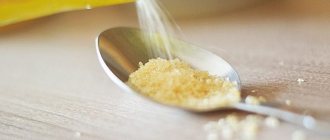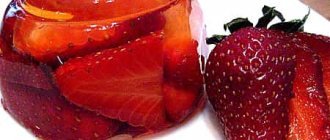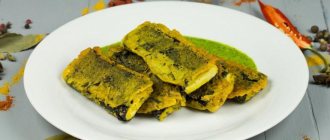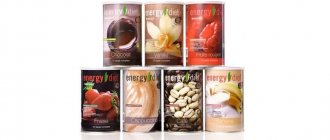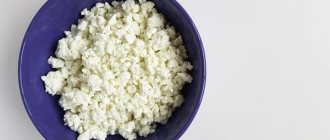The confectionery and culinary world does not rest on gelatin alone. This familiar thickener also has its own substitutes: agar-agar and pectin. Let's figure out in this article what gelatin, agar-agar and pectin are, where and how they are used.
This is perhaps the most well-known type of thickener , made from bones, tendons and cartilage of pigs or cattle by prolonged boiling with water. The resulting solution is evaporated, clarified and cooled until it turns into a jelly, which is later cut into pieces and dried.

Gelatin is a universal product that is used to prepare a fairly large number of dishes: desserts (jelly, puddings, panna cotta, mousses), all kinds of jellies and jellies, sauces. In addition, it is also the most affordable. You can buy gelatin at any grocery store.
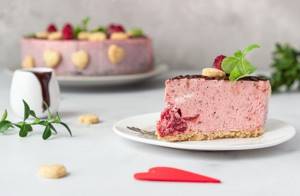
One of the main disadvantages of gelatin is its animal origin, that is, it is not suitable for use during fasting and for vegans. But if you do not adhere to these rules in your diet, then feel free to use gelatin in your kitchen.
There are two types of gelatin:
- sheet (in plates)
- powdery.
The first one is most often used in confectionery, since it is easier to work with and it dissolves more easily in any amount of cold water. But such gelatin is difficult to find in regular stores; as a rule, it is sold in specialized confectionery stores.
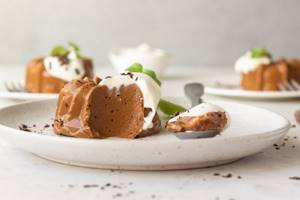
Powdered gelatin is almost colorless or yellow granules without taste or odor. It differs from sheet gelatin in that it swells strongly in cold water, but does not dissolve. And when using such gelatin, you must strictly follow the information indicated on the packaging regarding the amount of water and soaking time.
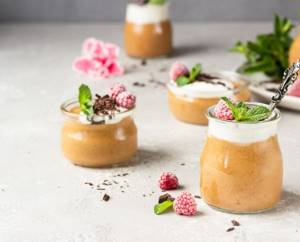
Rules of use:
- Be sure to soak in water in a ratio of 1:6 (for powdered gelatin), and for sheet gelatin, take enough water to cover the gelatin plates 3-4 times;
- Gelatin can be brought to a boil, but under no circumstances should it be boiled! This will significantly reduce its gelling properties;
- Follow the pouring sequence: always pour the powder into the water, and not vice versa. Otherwise, lumps may appear, which are then difficult to get rid of;
- gelatin hardens only at low temperatures, so products with gelatin should be placed in the refrigerator;
- You should not dissolve gelatin in juices and acidic liquids, it may not work. And you should not use gelatin in dishes that contain sour fruits such as pineapple and kiwi;
- Before adding soaked gelatin to a dish, you should make sure that it is completely dissolved so that there are no lumps in the finished dish. To do this, gelatin and water can be brought until the first bubbles appear, stirring thoroughly so that it is completely dispersed in the liquid.

Agar-agar (more often confectioners use the abbreviated name “agar”) is a plant analogue of gelatin, obtained by extraction from red and brown algae growing in the Pacific Ocean, as well as in the Black and White Seas.
It is thanks to its plant origin that agar-agar is very popular among vegetarians.
Is it possible to replace gelatin with agar-agar?
The scope of application of agar-agar is very wide . It can easily replace gelatin in any recipe; in addition, it is used in the preparation of gelled desserts, custards and puddings.
It is better to use agar to make marmalade, as it will produce a more stable and solid delicacy. In small dosages, it perfectly thickens various sauces.
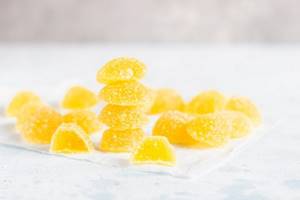
And with all its advantages, agar-agar also has a very low calorie content , but is rich in fiber - a real dream for those losing weight, although you should not forget about consumption in moderation.
Agar-agar is sold in the form of plates (flakes) and powder, the latter is much more convenient to use. You can find agar in large chain supermarkets, confectionery stores and health food stores.

In addition to its appearance, agar-agar is distinguished by :
– grade: highest (it is white or light yellow in color) and first (its color varies from yellow to dark yellow); – density: Agar M 500, Agar G 700, Agar-900.
The higher the number in the name, the greater the density of the resulting product and the less powder will need to be consumed. But at the same time, the cost of agar-agar itself will increase proportionally.
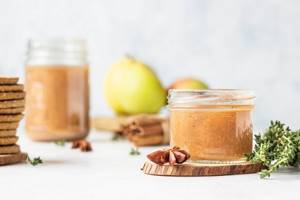
Is it possible to replace gelatin with agar-agar? Gelatin, agar-agar and pectin.
Traditional medicine often recommends treating joints with gelatin.
Gelatin is a substance of animal origin. An important component of this substance is collagen. Research by American scientists has confirmed the effectiveness of treating joint diseases with gelatin.
Arthritis, osteoarthritis, osteoporosis, inflammation, dislocations, sprains and fractures are cured faster when using recipes using gelatin. In addition, gelatin serves as an excellent prevention of these diseases.

A healthy recipe is simple: pour 1 tsp overnight. gelatin with water, use cooled boiled water (0.5 cups. In the morning, bring the resulting contents (gelatin should swell) to a whole glass. Add honey (1 tsp), stir thoroughly. Use the mixture on an empty stomach.
The course of treatment is 10 days, rest for 10 days, continue treatment. The duration of such treatment depends on the need and well-being.
For prevention purposes, take the mixture every 3 to 4 days. It is important to know that gelatin is present in pure form in some products. Therefore, it is very important even for healthy people to consume marmalade, jellied meat, and aspic.
As for the benefits of gelatin, then.
Well. Aesthetically - applied. Gelatin allows you to prepare many beautiful and festive dishes: aspic, jelly, as well as decoration elements, such as lanspic.
For health: dishes with gelatin and in general with highly concentrated kozho/rogo/bone broth (jellied meat, khash) are an indispensable remedy for accelerating the healing of bones in fractures.
You can use agar-agar or pectin, because the animal origin of gelatin, to be honest, makes me a little nervous - you never know what these same animals were fed.
Agar-agar (French Gelose), a jelly extracted from seaweeds (especially Eucheuma Spinosum Ag., E. Gelatinae Ag., Gelidium Cartilagineum (Grev. etc.) East Asia; sold in the form of strips. Used for finishing tissues and as a food product; in bacteriology - for spreading; swells greatly in water.
Agar, or agar-agar, is a natural product that has been used as a thickener.
Obtained from red and brown algae and forming a dense jelly in aqueous solutions.
Agar consists mainly of polysaccharides and is widely used in the confectionery industry.
This is a product that has properties beneficial to the human body: it promotes metabolism and the removal of heavy metals from the body,” “used in the treatment of menorrhagia,” “the enveloping properties of agar-agar are useful for the treatment of heartburn and reflux-related disorders,” “actively eliminates human heavy metals in the body and at the same time is an integral component in the production of graphite rods of nuclear reactors", "used in microbiology and in the production of especially high-quality coated paper, widely used in the food industry, added to marmalade and bakery products. And the list of its applications can be continued.”
Agar (agar-agar), made from red seaweed, also has a beneficial effect on the body. Agar normalizes digestion, facilitates liver function, and is beneficial for the thyroid gland due to its iodine content.
The swelling substances of the raw material do not decompose either in the acidic environment of the stomach, through which they pass very quickly, or in the alkaline environment of the intestine, and as a result of strong swelling they increase the contents of the intestine, which causes its peristalsis. Thus, agar (agar-agar) acts as a mild laxative. Agar contains calcium, magnesium, iron, copper, vitamins E, K and B 5, zinc.
Pectin was first isolated from fruit juice. This compound is found in large quantities in berries, fruits, and plant stems. It is localized in the primary cell wall of all higher plants. By chemical nature, pectin is a macromolecular compound belonging to heteropolysaccharides.
The main component of pectin is polygalacturonic acid, which is partially esterified with methyl alcohol. Only if the degree of esterification exceeds 50% is it highly esterified pectin, if below 50% is it low-esterified. Pectin has different gelling mechanisms. Highly esterified forms gels in the presence of sugar and acid. Low esterified pectin forms gels regardless of the sugar content and acidity of the medium. Gelation requires the presence of divalent metal cations, such as calcium or magnesium.
Pectin is a natural polysaccharide found in almost all plants. Traditional consumers of pectin are confectioners. It is widely used in the food industry in the production of jam, marmalade, marshmallows, marshmallows, jelly, baby food, etc. It is also used in medicine, in particular in pharmacology, in the treatment of the gastrointestinal tract, for the prevention of diabetes mellitus, and cancer. Pectin reduces cholesterol in the body, helps normalize metabolic processes in the body, improves peripheral blood circulation, as well as intestinal motility. But perhaps its most valuable property is that it is able to cleanse living organisms of harmful substances. Moreover, this natural “Cleaner” works very effectively, without leaving behind any “garbage” and without disturbing the bacteriological balance of the internal environment. Pectin removes toxic metal ions, pesticides, and radionuclides from the body.
In terms of its chemical composition, pectin is a derivative of high molecular weight carbohydrates. It is a polymer homologous series of partially methoxylated galacturonic acid. In the human body, the carboxyl group of pectin - c is capable of attaching heavy metals or other harmful substances present in the body in exchange for the H ion. Once in the gastrointestinal canal, pectin forms gels. When the mass of pectin swells, it dehydrates the digestive canal and, moving through the intestines, captures toxic substances.
Pectin is not digested until it reaches the colon. Its further transformations depend on the intestinal autoflora (its composition, functional activity), as well as on the speed of passage through this section of the intestine. The remaining pectin is excreted from the body along with a small amount of galacturonic acid compounds.
In the process of digestion of food, demethoxylation (i.e., elimination of the methoxy group - CH) of pectin promotes its transformation into galacturonic acid, which combines with certain heavy metals and radionuclides, resulting in the formation of insoluble salts that are not absorbed through the mucous membrane of the gastrointestinal canal and are excreted from the body.
Pectin adsorbs lead acetate more strongly than activated carbon. It has an active complex-forming ability in relation to radioactive ones.
Pectins are high molecular weight polysaccharides present in all land plants and a number of algae. The property of pectin - the ability of its solutions to form strong gels, or jellies - allows it to be used as a natural gelling product in the food industry. The raw materials for obtaining pectin are apples, citrus fruit peels, watermelons, sugar beets, and sunflower baskets.
Pectin removes heavy metals (lead, mercury, zinc, cobalt, molybdenum, etc.) and long-lived (with a half-life of several decades) isotopes of cesium, strontium, yttrium, etc. from the human body. Pectin is also capable of collecting and removing from the body biogenic toxins, anabolic steroids, xenobiotics, metabolic products and biologically harmful substances that can accumulate in the body: cholesterol, bile acids, urea, mast cell products. Pectin is effective for diseases associated with metabolic disorders, especially with disorders of lipid and carbohydrate metabolism, accompanied by endointoxication at an early stage: diabetes mellitus, gastrointestinal diseases, liver and pancreas diseases, obesity. Pectin is used to treat diabetes, atherosclerosis, hemophilia, in the healing of wounds and burns, in the treatment of bacterial infectious diseases of the gastrointestinal tract, and so on.
Gelatin is a mixture of animal protein substances that, when heated, form a sticky solution that hardens into a jelly. Gelatin is made from bones, tendons, cartilage, etc. by prolonged boiling with water. Gelatin is a colorless, tasteless and odorless thickening agent obtained from beef and veal bones and cartilage; Some types of gelatin are a by-product of processing pig skin. It is used in cooking for making jellies, mousses, jellied dishes, marmalade, ice cream, etc. In order to make a dish using gelatin, carefully measure its amount. Too much gelatin will make the dish rubbery, too little and the dish will not work out at all. To soften gelatin, pour a small amount into cold liquid. Leave without stirring for 5 minutes until the gelatin becomes soft and swells. When heated, its spongy consistency will melt quickly. The mixture to which the gelatin will be added must be warm enough so that it does not immediately thicken and turn into lumps. Melt the gelatin completely while heating, but do not allow the liquid to boil or the gelatin's ability to thicken will be reduced. The main thing is to stir all the time so that the liquid does not become lumpy or separate. When adding fruits to gelatin, cut them into small pieces - large pieces will push the gelatin away. Raw pineapples, kiwis and papaya contain a lot of enzymes that break down gelatin. To quickly cool the gelatin, place the bowl with it in another, larger bowl filled with ice water. Stir constantly with a spatula until the mixture begins to rise, without allowing it to form lumps. Do not try to speed up this process in the freezer; the mixture may crystallize. As soon as the dessert with gelatin hardens, it must be removed from the mold. Place the bottom of the mold in a bowl of warm water for 10 seconds (no longer, otherwise the gelatin may melt. Place the plate on the mold, quickly turn over and shake the mold to release the dessert. How much gelatin should you put in? 1. Our standard package = 11 g gelatin powder. One package can thicken 450 ml. To check the dissolution of gelatin, take a little solution into a spoon - there should be no visible crystals. In Western recipes, the required amount of gelatin is usually given in leaves (plates. This is how they (and now we) usually use this product and is sold. The fact is that these transparent leaves are used in Christmas gingerbread houses as "Glass" for windows. One such leaf weighs two grams, so it is not difficult to convert a Western recipe to our domestic gelatin. Ilya Lazerson, assessing the effectiveness of imported and domestic gelatin, recommends additionally increasing the dosage rate by one and a half times. Thus, 2 grams of imported gelatin (litstick) is equivalent in effect to 3 grams of our domestic one. I would also like to add a few words on the topic of jelly. The amount of liquid intended for swelling of gelatin must be calculated into the total amount - in liquid, for example. If you need to take 1 liter of juice to prepare the finished product, then you need to soak the gelatin with a certain amount of juice or replace the juice with water based on this particular liter. (Ugh, I hope it’s clear. The introduction of a gelatin solution into various products is also somewhat different. We mean, say, the preparation of sour cream - curd jellies - soufflés. To avoid gelatin lumps or threads, you need to gradually add 6-7 spoons of the prepared gelatin to the gelatin solution. mass. In this way, the gelatin is “hardened.” At the same time, the temperature of both the solution and the added mass should be the same. And finally, how to remove the jelly (cake, aspic) from the mold. Pour enough warm water into a large container (bowl, sink) water, in which to place the mold for a short time. Squeeze the edges of the jelly in the mold with your hand and then shake the mold a little to make sure that the jelly has left the mold. Then cover the mold with a plate moistened with water and turn it over with a sharp movement. Wet the plate to make it easier correct the jelly (cake, aspic) if it is not laid out in the right place for us (in the sense of crooked - askew. My practice shows that the method can only be used for small desserts. When turning over a large jelly cake (a couple or more kilograms), it can slip and hang over the edge of a plate or dish, which is not at all what we want. About the benefits of gelatin. Although gelatin belongs to the class of non-essential proteins, it is useful because it contains two amino acids in large quantities, proline and hydroxyproline, the presence of which is especially important for the development, maintenance at the achieved level and restoration of connective tissues. Eating products containing gelatin can increase the growth and volume of connective tissue.
What will help make your nails beautiful and healthy? Delicious desserts. No, there is no mistake here. You can really restore the beauty and healthy, well-groomed appearance of your natural nails with the help of desserts! Surprised? There is nothing surprising here, because it is no secret that the foods we eat contain many useful nutrients, vitamins and microelements. So what’s stopping us from taking something healthy and making a delicious dessert?
Everyone knows that calcium is necessary for the health and growth of nails. If there is not enough calcium in your body, your nails will be thin, dry and brittle. Very often, cracks on the sides of the nail plates are associated precisely with a lack of calcium. Dairy products, rich in calcium and almonds will help you fill the lack of calcium in the body.
I can suggest you prepare a very tasty and quick curd dessert with apricots! To do this, take 1 kg of cottage cheese, half a glass of crushed almonds, half a glass of low-fat sour cream, sugar to taste and about five ripe apricots. Mix cottage cheese with sour cream and sugar, and then beat with a mixer until a soft, homogeneous consistency. Remove the pits and peel from the apricots, cut into cubes and carefully mix with the curd mass. Sprinkle crushed almonds on top of the dessert. This delicate curd with apricot can be served as a separate dish for breakfast or afternoon snack, or as a dessert for lunch.
By the way, the apricot that is part of my curd dessert contains another element that is very necessary for the health and beauty of nails - iron. Even a slight deficiency of iron in the body can lead to split nails.
Are your nails growing slowly? Most likely you are lacking magnesium, add bananas to your dessert. By the way, bananas contain not only magnesium, but also many other useful microelements and vitamins.
What healthy things can you prepare besides cottage cheese dessert with fruit? Perhaps the healthiest dish for our nails can be considered... jelly! The thing is that gelatin, the main component of any jelly or mousse, is very rich in calcium and collagen. Collagen is a connective tissue protein and can rightfully be called the main building material for nail plates. Lack of collagen has a very negative impact on nail health. There’s no time for beauty here; how can thin, peeling and cracking nails be beautiful? Of course not! Therefore, do not forget to include gelatin dishes in your menu.
I know a lot of recipes for various jellies and mousses. The proportions and method of preparing classic jelly are always written on the bags of gelatin and jelly powder; all we have to do is choose the additives! I always use natural fresh fruit and berry juices to make jelly. You can add pieces of fruit and various berries to the jelly, you can add whipped cream or chocolate, it all depends on your imagination and taste preferences.
Rules of use:
- Agar-agar dissolves only at high temperatures. The temperature of the liquid should be 95-100 degrees;
- agar-agar is thermoreversible, meaning it can be reheated without loss of quality;
- Pre-soaking in liquid is not required, but before use it is worth mixing the agar with a small amount of sugar to prevent lumps from forming.
Pectin, like agar-agar, is also a product of plant origin, which is a powder obtained by extraction from certain products. It is obtained from apples, pears, citrus fruits, and beets. Pectin is odorless and its color varies from light cream (citrus pectin) to brown (apple pectin).
Pectin is actively used in confectionery products (marshmallows, jelly, marshmallows, marmalade), for the preparation of jams, preserves, and in the production of ketchup, mayonnaise, dairy products and ice cream. Such a wide range of uses of pectin is due to the fact that it is a gel-forming, stabilizing and moisture-retaining agent, as well as a thickener and clarifier.
Pectin is extremely rare on supermarket shelves, but it can be bought in specialized confectionery stores or ordered in online stores.

Pectin, unlike gelatin and agar-agar, significantly reduces cooking and heating time , and therefore retains more nutrients in the original product. And by adding pectin, you can reduce the amount of sugar used without compromising the taste.
There are several types of pectin , each of which is used in certain cases:
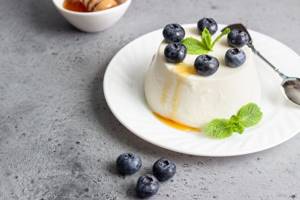
- yellow or irreversible pectin. Such pectin does not dissolve when reheated, which is why it is used in the preparation of heat-resistant jams, confiture and marmalade. The structure of such products is more viscous than that of our usual jam;
- NH pectin or reversible pectin. It dissolves when heated and hardens when cooled. Using this pectin, the same type of puree can be turned into either a sauce or a jelly. This pectin is used to prepare dessert sauces and jelly for cakes (in the form of a coating or layer). If, for example, you add this type of pectin and agar-agar to marmalade at the same time, it will become a little more brittle and brittle, and if together with gelatin, it will become “rubbery”;
- pectin FX58 – interacts with calcium-containing products, therefore it is excellent for making milk jelly or foam.
Should gelatin be replaced with carrageenan?
What can replace gelatin? Carrageen is a product created from Irish moss. It is worth replacing gelatin only when preparing the following dishes:
- marmalade;
- jam;
- jam;
- confiture;
- paste;
- souffle.
Carrageenan is not suitable for making cake creams or other jelly-shaped products.
Often used to replace gelatin in vegetarian cuisine.
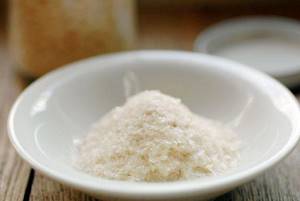
Rules of use:

– pectin must be mixed with a small amount of sugar before use so that it is distributed evenly and does not form lumps; – pectin should be introduced into a mass (liquid or puree) heated to a temperature of approximately 50 degrees; – the mass with pectin must be brought to a boil and immediately removed from the heat.

Is it possible to interchange these three gelling agents?
In some cases this is allowed, but here it is important to take into account the properties of each substance and its proportions relative to the thickened mass. Therefore, I would advise you to use exclusively proven recipes from confectioners you trust, and also carefully read the instructions on the package. And everything will work out!
Should gelatin be replaced with guar gum?
What can replace gelatin? Guar gum will be an excellent substitute for gelatin if you follow the proportions. The gelling effect of guar gum is six times greater than the gelling effect of gelatin, so it is important not to forget about this during cooking.
It is worth noting that adding guar gum to both liquid and dry ingredients is prohibited. You must first add this product to the liquid ingredients and then to the dry ingredients. Then the dry and liquid ingredients are poured into one container and mixed thoroughly so that no lumps form.
Should gelatin be replaced with arrowroot?
Suitable for replacing gelatin when thickening acidic liquids. But at the same time, dairy products cannot be thickened with arrowroot, since their interaction with this product leads to coagulation.
Arrowroot should not be used to thicken products that will subsequently be exposed to high temperatures.
Before adding arrowroot to a hot liquid, it must be dipped into a cold one, and heating this product for more than 30 seconds is not recommended.
Having analyzed all the products that can replace gelatin, it can be noted that each of them has certain properties and is not able to replace gelatin in all recipes. The only exception is agar-agar. This product can not only replace gelatin, but also has many advantages. Therefore, if you have a problem with what to replace gelatin with, feel free to choose agar-agar. You can be 100% sure that you will not regret it.

